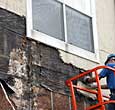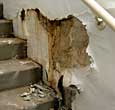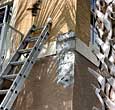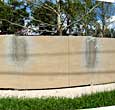(321) 356-0218




Numerous reports of accelerated failures in institutional, commercial and residential buildings exterior stucco wall systems are raising concerns about structural soundness at many properties. Designers and contractors are looking for other system choices and or methods for avoiding the use of stucco.
Stucco Systems
Traditional Stucco
Traditional stucco, unfortunately seldom used now, employed mixes utilizing lime. Lime mixes provide more flexibility and are, to a large degree, “self-healing” when cracks develop due to normal settlement and structural movement. Lime mixes are, to a large degree, “self-healing”. Lime also acts as an inhibitor to mold growth.
Present Day Stucco
The movement away from lime additives, with modern day Portland cement mixes, has resulted in more rigid – brittle surfaces less resistant to cracking. Open cracks develop in the stucco surfaces that do not “heal” with time. Differential pressure on the structure caused by wind effects or HVAC system operation or draw significant amounts of water through open cracks. This water can become trapped inside the wall cavity leading to moisture related failures and costly interior damages.
EIFS
EIFS, or Synthetic Stucco, is a post WW2 system. EIFS utilizes polymer bases or modifiers to the cementitious ingredients to promote higher degrees of flexibility and resistance to cracking. Properly applied, it can provide higher life cost benefits. However, it is still susceptible to the same failure causations and mechanisms as conventional stucco.
Primary Causations
• Unsuitable materials are used for the application.
• Construction design details are often not provided or are ignored.
• Window and door openings are not provided or properly flashed, sealed, and caulked.
• Flashing and penetrations are not properly sealed.
• Other unique design and construction factors result in accelerated failure.
• Materials are not applied within the temperature and humidity limits specified
• Moisture is “trapped” within the wall cavity.
• Mold Growth and indoor air quality problems can occur as a result of water intrusion.
Mechanisms promoting water damage
• Exterior joint penetrations
• Air pressure differentials
• Entrapment of internally generated water vapor within structure
• Entrapment of exterior source water within the structure
• Material permeability
Mr. Albers is an expert witness in a court of law, but is not an attorney. If you have legal questions related to any of these topics, please consult an Attorney.

